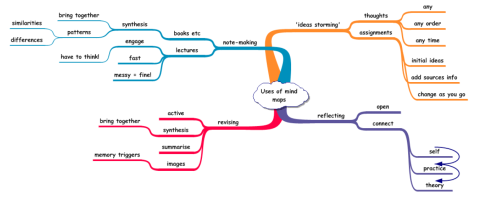
Sidebar navigation
- How to study online
- Learning preferences
- Types of study
- How to beat procrastination
- Organisation and time management
- Mind mapping
- Speaking skills and presentations
-
Back to
- Academic writing style
- Reports and essays: key differences
- Basic data interpretation
- Basic essay structure
- Better Essays: Signposting
- Better essays: paraphrasing
- Commas and its
- Dissertation Tips
- Essays: task words
- Experimental laboratory reports in engineering
- Commonly confused words and improving vocabulary
- Key features of academic reports
- Paragraphs main body of an assessment
- Reflective writing introduction
- Writing clear sentences
- Writing: flow and coherence

Thinking skills
Mind maps can help you to organise your ideas, plan your assessments and communicate visually
Mind maps are a visual way to represent your ideas or capture your thinking. You can use mind maps throughout your university career.
Mind maps use words and images to create strong associations that help you remember what you're studying. Some people use mind mapping as a more 'natural' form of note-taking. You can use mind maps to brainstorm, plan, revise and more.
You can make mind maps in lots of different ways so don't be afraid to explore and develop a style that suits you. You can be as creative or messy as you like – mind maps don’t have to be pretty and can be as colourful as you need. Lots of people use images to help them remember or represent information in mind maps. Images don't have to be detailed as long as you understand them.
Consider using a pen and paper to draw your mind map or explore mind mapping software available online.
Reasons to use mind mapping
Mind maps can help you:
- Improve your memory with visual cues, words and images
- Identify relationships between different topics
- Develop your subject understanding
- Connect your ideas and experiences to the literature you study
- Explore subjects broadly and in depth
- Organise your thoughts to plan and structure assignments
- Decide what to include or exclude in projects, including contextual information
- Introduce new ideas and resources to a topic as you learn more about it
Building a mind map
- Write your map subject in the middle of your page. Your content will link to your subject and spread out from the main heading. Your subject could be a topic or idea, or information from a text.
- Add key ideas to your map by writing their headings on the page and drawing a connecting line between them and your main heading. Continue breaking each section down and adding links between subjects to create smaller, specific mind maps on the page. This is a great chance to explore specific topics more deeply.
- Use key words or images to represent each piece of information.
- Link new content to your current map – ideas should always be connected to something else in the mind map. Adding new information to your current map layout encourages you to engage with the content so you can decide if it needs to be included and where it fits in your structure.
- Change the style, size or colour of items to represent important content.
- Use colours to identify themes and relationships. Some information in your map may fit more than one map 'branch'. Colour-coding and extra connecting lines will help you keep track of this.

Mind map created using Inspiration software, which is available on the University network.
Download our mind mapping revision sheet
Download this page as a PDF for your mind map revision notes.
